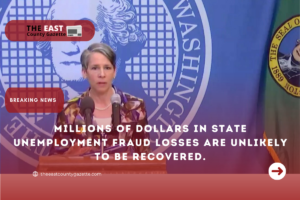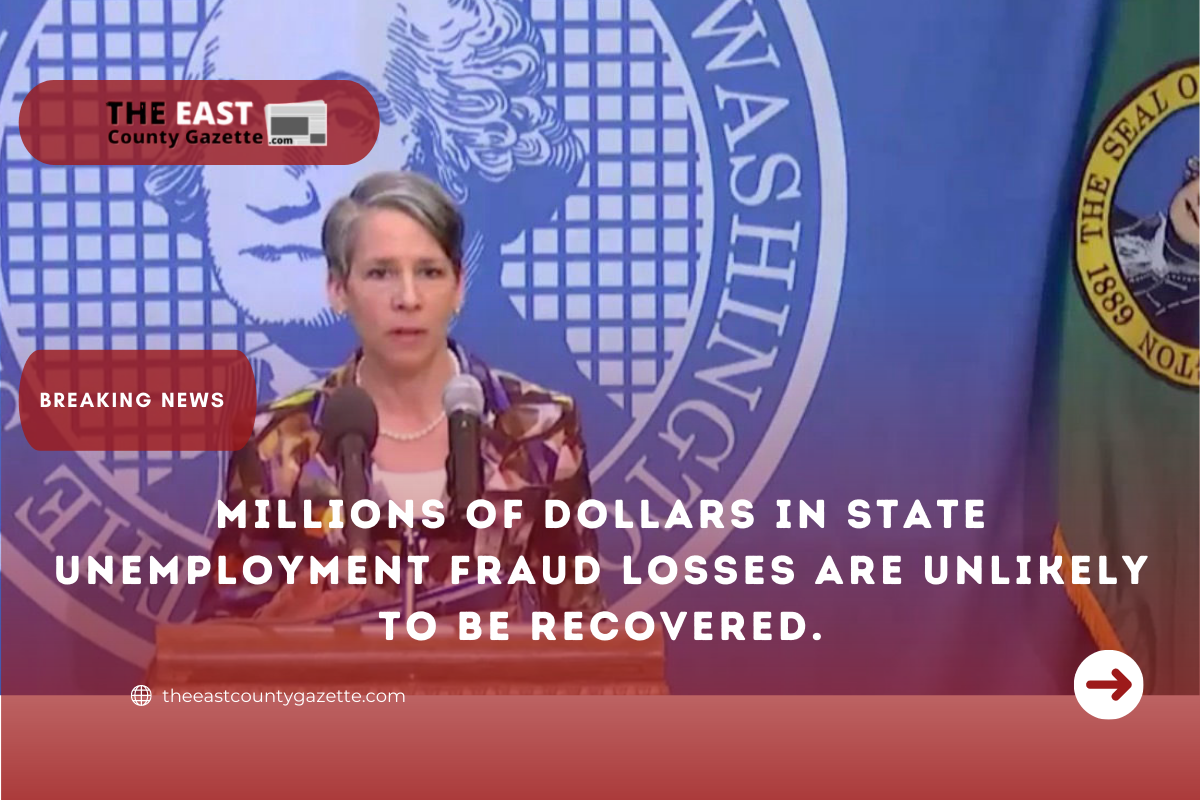The criminals who stole nearly $650 million in state and federal unemployment benefits from Washington during the chaotic early stages of the pandemic in 2020 did so in a matter of weeks, according to reports.
It has taken nearly two years for the state to recoup approximately $380 million, or nearly 60% of the funds that were originally lost.

Read More: Biden Will Nominate a Black Woman to the United States Supreme Court by the End of February.
Moreover, while Washington’s recovery percentage appears to put it well ahead of other states that have suffered from similar fraud, newly disclosed state data and recent court cases indicate that much of what Washington hasn’t recovered will not be recovered in the future.
Earlier this month, the state Employment Security Department released the names of the banks and other financial institutions to which the agency had sent $577 million, or approximately 90%, of the fraudulent benefits it paid out on thousands of bogus unemployment claims in the spring of 2020, according to the department.
(The remaining 10%, according to state officials, was distributed among several thousand other financial institutions.)
The banking information, which was provided to The Seattle Times after several requests, provides a glimpse into the financial mechanics of a multibillion-dollar crime spree that caught Washington and other states by surprise — and caused benefits to be delayed for tens of thousands of Washingtonians who were made jobless by the pandemic.
The list reveals that criminals attempted to have benefits wired to tens of thousands of accounts at institutions ranging from JP Morgan Chase, the largest bank in the United States, which received $42.5 million in allegedly stolen ESD funds, to Boeing Employees Credit Union in Washington, which received nearly $1.2 million in allegedly stolen ESD funds.
State records show that even KeyBank, the Cleveland-based bank that handles ESD’s financial transfers to other financial institutions, appears to have wired itself approximately $18.3 million in allegedly stolen ESD benefits, according to the documents.
Importantly, the list specifies exactly how much of the money has been returned and where any remaining funds might still be able to be found.
Banks have voluntarily returned to ESD a little more than half of the $577 million that was sent to the 75 financial institutions, according to agency records.
However, while more funds are potentially recoverable, additional recoveries could take years to complete and will likely result in significantly lower returns, according to state and federal officials.
A large portion of what the state has recovered has returned relatively quickly. When federal investigators discovered suspicious benefits transfers from ESD, they were able to alert financial institutions, which in some cases were able to return the funds to KeyBank.
In other instances, suspicious ESD transfers appear to have tripped the financial institutions’ own fraud-detection systems, prompting them to freeze the accounts of those who were suspected of fraud. According to state records, all 75 institutions’ banks have returned at least a portion of the funds transferred.
As a result of the existence of a veritable fraud mother lode, the early recovery efforts were aided significantly: nearly half of the recovered funds came from Green Dot, an Austin-based prepaid debit card company that has returned approximately $182 million of the $266 million ESD sent it, according to state records.
The options will become significantly more limited in the future. According to ESD and the state attorney general’s office, the state attorney general’s office is concentrating on 37 of the 75 financial institutions that are believed to still have ESD unemployment benefits in thousands of accounts used by suspected criminals.
Although banks are required to turn over deposits under court orders and through a complicated legal process known as forfeiture, banking officials said they typically do not do so because they do not want to risk being sued by account holders.
This has necessitated the Attorney General’s investigators establishing, among other things, that funds in each of thousands of suspect bank accounts were obtained fraudulently from ESD by presenting evidence of such fraud.
There is no shortage of evidence: on many suspected bank accounts that received unemployment benefits, for example, the account holders’ names, Social Security numbers, and other data do not match the information on the unemployment claim, which raises the question of whether the accounts were opened fraudulently.
(It is almost certain that the investigations will bring up questions about why so much public money was sent to accounts that had so many red flags.) However, the investigations take a significant amount of time. So far, the Attorney General’s office has brought three forfeiture actions against the defendants.
According to the ESD and the Attorney General’s Office, the answer to one major question — how much retrievable money remains in all 37 financial institutions — will not be known until the forfeiture cases are completed. However, based on the three cases that have been filed thus far, it appears that the total number of cases may be relatively small.
For example, the Attorney General’s Office filed a forfeiture action in King County Superior Court last week for $6.7 million in allegedly stolen unemployment benefits at JPMorgan Chase, according to court documents.
The settlement follows one against Wells Fargo in December for $7.4 million and another against New Jersey-based TD Bank in October for nearly $500,000, both in the same month. According to state records, Wells Fargo received $42.9 million in suspect benefits from ESD, while TD Bank received approximately $6.2 million.
All three banks have stated that they will abide by the court order. Upon completion of the legal process, a JPMorgan spokesperson stated that the bank was “eager to return the money.” State officials assert that they have no reason to believe that any of the banks will challenge any court-ordered forfeiture of their assets.
However, this only serves to highlight the bleak reality of fraud in the digital age. Even banks that are eager to return suspect funds are unable to do so because they do not have the funds in question.
Even if JPMorgan Chase, Wells Fargo, and TD Bank comply with the forfeiture orders, nearly two-thirds of the $91.7 million in fraudulent funds initially sent by ESD to these three banks will remain unaccounted for, and it is possible that this will continue to be the case in the future, according to state records and officials.
TD Bank was targeted by scammers who stole approximately $4.2 million from the bank’s accounts before the accounts could be frozen, according to the attorney general’s office, which admitted this in October.
When asked if any outstanding funds sent to Wells Fargo and JPMorgan Chase Bank were also likely withdrawn, Dan Jackson, a spokesperson for the attorney general’s office, said it was “fair to say the same assumptions likely apply,” but that the investigation into each bank was in a different stage.
If those assumptions are correct, it means that approximately 80% of the unrecovered funds are no longer in the possession of those three banks.
According to state authorities, whether that percentage will hold true for the remaining 37 financial institutions is currently unknown. “At the end of the day, each individual bank investigation will determine how much money can be recovered through these forfeiture actions,” Jackson explained.
In contrast, if the current percentage holds true, it is possible that approximately $210 million, or approximately a third of the total theft from 2020, is no longer in the possession of those financial institutions.
Recovery efforts will continue even after the property has been forfeited, according to state and federal officials. Officials with the Attorney General’s office have stated that funds that are no longer in the possession of financial institutions may be the subject of separate federal investigations.
Nick Demerice, a spokesperson for the ESD, said, “We are absolutely committed to attempting to recover every dollar we can.” “However, it will be a time-consuming process.”
State and federal officials, on the other hand, acknowledge that it is difficult to track down funds that have been withdrawn. Even in cases where federal investigators have identified suspects — such as the two Nigerian citizens charged in the ESD fraud — stolen funds are frequently moved in ways that make it difficult to track them down and return them to the proper owners.
As Emily Langlie, a spokesperson for the United States Attorney’s Office in Seattle explained in a recently emailed statement, “Law enforcement has been able to trace some funds moving to financial institutions overseas,” but “much of the money is withdrawn from domestic bank accounts and laundered in many complex ways.”
Among these are “the purchase of luxury goods or vehicles that are then shipped overseas, the conversion of funds into cryptocurrency, or the funding of debit cards or gift cards in order to distribute the stolen funds as quickly as possible,” according to Langlie’s report.
Private fraud experts are also pessimistic about the prospect of recovering withdrawn funds.
Because criminals haven’t transferred the funds from one traditional financial institution to another, “the money is gone,” says Jason Kratovil, a fraud expert at SentiLink, a company that provides anti-fraud and identity verification services to banking and financial institutions.
According to Kratovil, in the case of funds stolen by suspected fraud rings from other countries, “you have to assume that a significant portion of those funds are now located overseas.”
Read More: Why AT&T and Verizon’s 5g Deployment at Airports Is a Stumbling Block
Nonetheless, from a purely financial standpoint, it appears that Washington has gotten off relatively lightly.
According to the federal Pandemic Response Accountability Committee, the state of Michigan, for example, paid out $3.9 billion to fraudsters in the last year. According to media reports, the state of California paid out $20 billion.
According to a summary released on January 3 by the U.S. Labor Department’s Office of the Inspector General, states’ unemployment fraud losses during the pandemic may account for a “significant portion” of the $87 billion in “improper” unemployment payments that federal officials have projected for the pandemic period.
Washington, which was one of the first states to be affected by the fraud, is also leading the way in terms of recoveries.
Workers’ compensation officials were unable to provide an official estimate of how much unemployment benefits were stolen nationwide during the pandemic and how much of that money has been recovered.
However, according to a summary by the Labor Department’s Office of the Inspector General, the agency has recovered or assisted states and other agencies in recovering only $790 million in fraudulent unemployment benefits since 2003.

